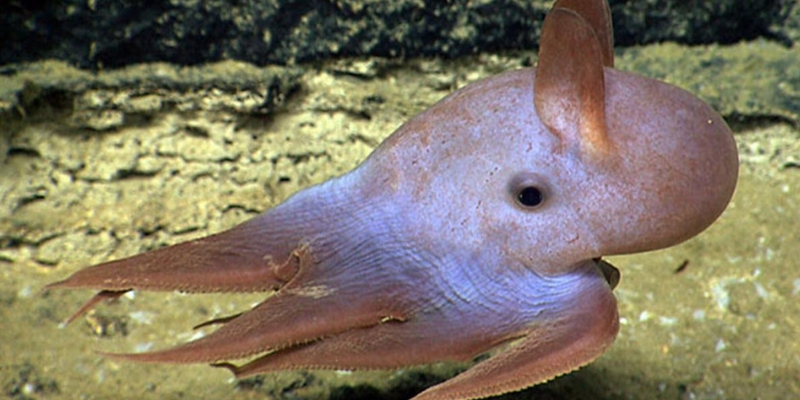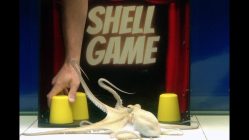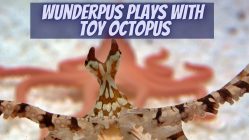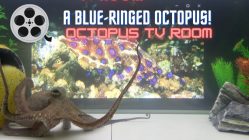
The Dumbo Octopus is one of those sea creatures, which even if you have never seen one, invokes images of cuteness. After all, any animal named after a beloved cartoon character is bound to be high on the cuteness scale.
In that regard, the Dumbo Octopus does not disappoint. “Cute” is a fair and just modifier to use when describing the Dumbo Octopus.
Dumbo Octopus Facts
- Scientific Name : Grimpoteuthis
- Common Name: Dumbo Octopus
- Size: 8 – 12 inches
- Weight: about 1 kg (2,2 lbs)
- Lifespan: average 3 years
- Found in: North and South Pacific Ocean & Atlantic Ocean
- Sub-Order: Cirrina
- Discovered: 1884
- Scientific Name : Grimpoteuthis
- Common Name: Dumbo Octopus
- Size: 8 – 12 inches
- Weight: about 1 kg (2,2 lbs)
- Lifespan: average 3 years
- Found in: North and South Pacific Ocean & Atlantic Ocean
- Sub-Order: Cirrina
- Discovered: 1884
The feature that gives dumbo octopuses their classic look is composed of two fins located on the sides of their heads. These fins can look like large ears. Some might say like those of a fictional flying elephant.
—Basic Facts About the Dumbo Octopus—

First thing is first — the term “Dumbo Octopus” is the popular name coined to describe not an individual species of octopus. Rather it is used to describe 13 species of octopuses of one genus.
When plants and animals are scientifically classified, the genus is the classification segment that comes before the species. For example, for us humans, we belong to the genus homo and the species sapiens.
In the case of the Dumbo Octopuses, they all belong to the genus Grimpoteuthis.
—Distribution of the Dumbo Octopus—
Species which are classified as Dumbo Octopuses have been found in the northern and southern Pacific ocean as well as the Atlantic Ocean.
—The Component Species of the Dumbo Octopus—
The 13 component species which are recognized to be bundled under the “Dumbo Octopus” name are:
- 1. grimpoteuthis abyssicola
- 2. grimpoteuthis bathynectes
- 3. grimpoteuthis boyle
- 4. grimpoteuthis challengeri
- 5. grimpoteuthis discoveryi
- 6. grimpoteuthis hippocrepium
- 7. grimpoteuthis innominata
- 8. grimpoteuthis meangensis
- 9. grimpoteuthis megaptera
- 10. grimpoteuthis pacifica
- 11. grimpoteuthis plena
- 12. grimpoteuthis tuftsi
- 13. grimpoteuthis umbellata
- *14. grimpoteuthis wuelker
If you are meticulous about details, you may have noticed that the list is comprised of 14 instead of 13 species. What gives?
The last entry on the list, Grimpoteuthis wuelker, is as of yet unconfirmed by the marine biology community to be a Dumbo Octopus. Some believe that it may be a sub-species of the grimpoteuthis plena or grimpoteuthis umbellata species as opposed to being its own stand-alone species.
With further study and perhaps a few barroom brawls, the marine biology community will eventually settle this dispute. For now, we carry on with 13 as the number of known Dumbo Octopus species.
—Common Characteristics of the Dumbo Octopus—
Being that there are 13 species of Dumbo Octopuses, there is plenty of margin for variation. However, there are certain traits that all species under the Grimpoteuthis genus share in common.
1- Dumbo Octopuses Have Fins

The feature that gives Dumbo Octopuses their classic look is composed of two fins located on the sides of their heads. These fins can look like large ears. Some might say like those of a fictional flying elephant. Yes, that is how these cephalopods acquired their popular name.
Octopuses Have Fins?
If your interest in octopuses is at the novice stage, chances are that your image of an octopus is confined to that of the incirrina octopuses.
“Incirrina octopuses, what the heck is that?” you might ask. Well, the 300 species of octopuses that exist are divided into two main divisions. Those being the cirrina and incirrina octopuses.
The Dumbo Octopuses belong to the cirrina side of the family.
Incirrina octopuses are those which have no solid supporting structure within their bodies. They are literally as malleable as they want to be. The cirrina octopuses, however, do have some form of internal structure.
The Dumbo Octopus and other cirrina octopuses have an internal cartilaginous-like internal shell. This gives the head firmer support and allows for muscle attachment of the fins to the head. Although still quite malleable, they are not as “squishy” nor as capable of sneaking into the tightest of spaces as their incirrina cousins are.
2- They Enjoy the Deep

Don’t expect to find a Dumbo Octopus when you are snorkeling at your favorite beach resort. Dumbo Octopuses are well adapted for living in some of the deepest waters of the world’s oceans.
Some live at depths of 13,000 feet below the surface of the sea. In part, this is what makes it difficult for marine biologists to properly study these cute cephalopods. While for a Dumbo Octopus such depths are routine, for us humans they are deadly.
To illustrate this, recreational divers would be stretching their limits if they dove to depths of more than 130 feet. Highly trained and skilled technical divers with specialized equipment cannot go beyond 350 feet. By doing some simple math you see how impossible it is for humans to take a look at a Dumbo Octopus on its home turf first-hand.
Fortunately, what we humans lack in deep-sea pressure endurance, we more than compensate for in the development of technology. Thanks to deep-water observation submarines, marine biologists have been able to observe Dumbo Octopuses in their native depth.
In fact, very recently a Dumbo Octopus was found swimming in the Java Trench at around 23,000 ft, which set a new depth record while it was the first time an octopus of this species was ever seen beyond hadal depths!
3- Dumbo Octopuses Prefer Cold Temperatures

If a creature has adapted to live in the deepest depths of the sea, chances are that they have also adapted to colder temperatures. Such is the case with the Dumbo Octopuses.
Water temperatures below 3,000 feet range from 40 to 36 degrees Fahrenheit. They can sometimes drop lower.
Indeed, the ocean depths to which the Dumbo Octopus is accustomed to is a chilly place.
4- Dumbo Octopuses Will Never Dowse You With Ink

If you have ever watched video footage of octopuses when they are faced with danger, you have seen how they release a cloud of dark ink in the water in order to confuse their predators as they make their escape.
Alas, once again, due to being a cirrina octopus, the Dumbo Octopuses are unable to do that. You see, Dumbo Octopuses lack the ink sacs of incirrina octopuses. They simply cannot produce ink.
Good thing for them that they aren’t much for writing either. Therefore the lack of ink production doesn’t hit them as hard.
Without Ink How Do Dumbo Octopuses Defend Themselves?
First, being that they live between 3,000 to 13,000 below the surface of the ocean, the number of natural predators that Dumbo Octopuses face are fewer than octopuses which spend their time in shallower water.
Even so, the Dumbo Octopus is prey for sharks and Giant Squid.
Their main form of defense is camouflage. While swimming in the open they can change color. This color can vary from white, pink, red or brown. This assists them in not being so easily spotted while in the open. While on the ocean floor they can assume more detailed camouflage pattern to match their surroundings.
While other species of octopus can impress you with their camouflaging capability — literally disappearing into their background — the Dumbo Octopus’ ability in this regard is more modest.
This is attributed to the fact that at such deep ocean depths, even the slightest of color camouflage is sufficient. There simply isn’t enough light at those depths to appreciate the detail. Also, while the depths of the oceans are a diverse ecosystem, the range of color variation in the substrate is minimal compared to that of shallower depths.
In other words, while a Mimic Octopus might scoff at the Dumbo Octopus’ curtailed range of camouflage, it is more than sufficient considering the conditions of its habitat.
5- Dumbo Octopuses Have Webbing Connecting Their Arms

When you look at the arms of a Dumbo Octopus you will notice that they have webbing connecting their arms. All octopuses share this physical attribute although it is not always so easily detectable. With incirrina octopuses this webbing usually does not go down more than one-third of the length of the animal’s arms. In the case of the Dumbo Octopus, this webbing stretches beyond the halfway point. In some Dumbo Octopus species, it goes beyond three-quarters the length of its arms. It is extremely noticeable.
This creates a blanket-style visual effect when a dumbo octopus stretches out its arms. Some people describe it as an umbrella-look.
What Does the Dumbo Octopus Use This Webbing For?
The purpose of this added webbing is not for aesthetic reasons. It is not to attract mates. Both males and females possess the same attribute. Neither is the webbing used to appear more intimidating to scare off potential predators.
The webbing is used primarily as an added tool for capturing prey. More on that when we discuss the hunting and eating style of the Dumbo Octopus.
6- Dumbo Octopuses Have Fuzzy Arms

Okay, maybe “fuzzy arms” is a bit of misnomer. We are not suggesting that Dumbo Octopuses are the Sean Connery or Burt Reynolds of the cephalopod universe.
What Dumbo Octopuses do have, however, are cilia on their suckers.
Cilia are strands that protrude from the skin of the octopus. At first glance, they can appear to be hair-like filaments.
The purpose of the cilia for both male and female Dumbo Octopuses is related to feeding. When perched on the ocean bottom or in their den, they can use the cilia to generate a steady current of water toward their location. This can passively lure in prey.
The cilia also assist in finding smaller prey when a Dumbo Octopus scans an area with its arms. In this regard, they are like finely-tuned extension antennae.
The female Dumbo Octopus uses the cilia to aerate her eggs when they are brooding.
There is also a theory that the Dumbo Octopuses use their cilia to assist in the maximation of their oxygen absorption. This is accomplished by using the cilia to aerate the water around itself. In so doing, refreshing the water that surrounds them with water that is less depleted in oxygen.
Since the Dumbo Octopus can absorb oxygen through its skin in addition to its gills, a steady motion of the cilia while at rest can be leveraged to increase oxygen absorption.
7- What do Dumbo Octopuses Eat

The Dumbo Octopus is a hunter that feeds on crustaceans, mollusks, and bottom-dwelling seaworms. Seeing that available food sources in the deep ocean are very limited, Dumbo Octopuses are considered opportunistic hunters. They will feed on any amphipod, copepod, and isopod they happen to come across.
Dumbo Octopuses have been observed hunting near thermal vents, where there are comparatively more animals to prey upon. Last but not least, the radula (which is a tongue-like structure covered with tiny teeth), of the Dumbo Octopus has degenerated, and so the Dumbo Octopus is able to swallow its entire victim without breaking it into pieces.
8- Locomotion and Hunting Style of the Dumbo Octopus
Since dumbo octopuses are naturally buoyant, that means that they can literally float statically over an area of their choosing. They can then pounce on prey below. Once they have captured their prey, they envelop it with their webbing and eat it whole.
Their buoyancy also allows them to swim by using their fins for propulsion. This means that dumbo octopuses are more prone to be in movement through the open water than their shallow-water cousins.
They can also walk on the surface of the seafloor using their arms as legs.
9- Dumbo Octopus Reproduction

The breeding style of the Dumbo Octopus species is similar to that of all other octopuses. The male inserts a sperm packet in the mantle of the female and she can then fertilize her eggs when she deems convenient. Shortly after breeding occurs the males die and the females die shortly after their eggs have hatched.
What is unique to Dumbo Octopus females is observational evidence of them brooding in groups. While the majority of other octopus females are solitary creatures — especially when brooding — evidence points to the contrary with the Dumbo Octopus.
Unmanned deep-ocean observation platforms have captured footage of hundreds of females perched on vents on the seafloor. These vents occur naturally and release geothermal heat from the earth’s crust.
While this pattern of behavior has yet to be studied in depth, it appears that the females prefer this sort of environment when caring for their soon to be hatchlings.
10- How Big Is a Dumbo Octopus?

Remember, when talking about a Dumbo Octopus you are referring to 13 different species. This means that sizes will vary.
The majority are small, ranging between eight to 12 inches in length. The largest specimen recovered measured just shy of six feet in length and was estimated to weigh 13 pounds.
—There is Still Much to Learn About the Dumbo Octopus—
Due primarily to its habitat being so difficult to access, the species that make up the Dumbo Octopus group also happen to be the ones that we know the least about.
However, in spite of having relatively little information about them, a few things are certain. They are beautiful creatures. They have definitely earned the right to be called cute. More importantly, they demonstrate how diverse the octopus world truly is and how much more study is needed.
With advances in marine research technology, we can only wonder what amazing new secrets about the Dumbo Octopus species will be revealed. Who knows what will be discovered.











